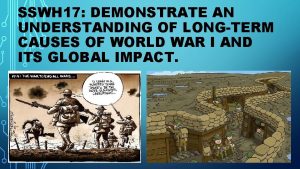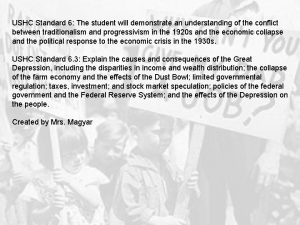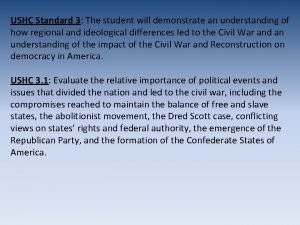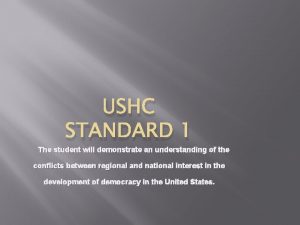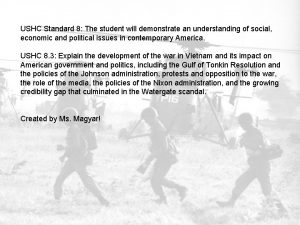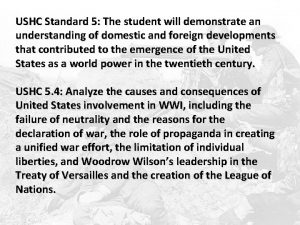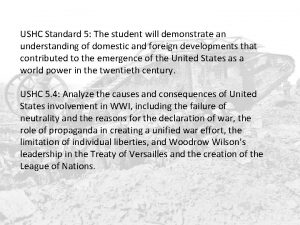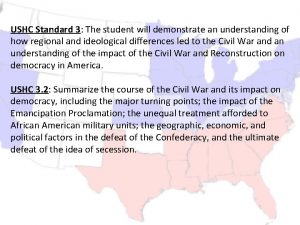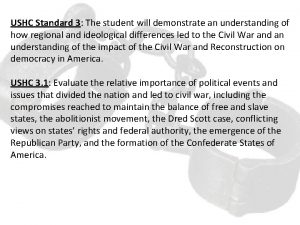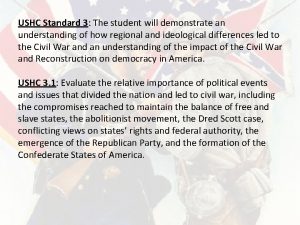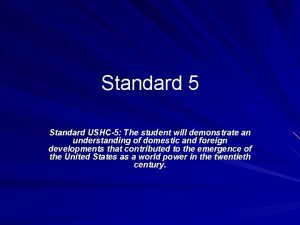USHC Standard 7 The student will demonstrate an














- Slides: 14

USHC Standard 7: The student will demonstrate an understanding of the impact of World War II on the United States and the nation’s subsequent role in the world. USHC 7. 3: Explain how controversies among the Big Three Allied leaders over war strategies led to post-war conflict between the United States and the USSR, including delays in the opening of the second front in Europe, the participation of the Soviet Union in the war in the Pacific, and the dropping of atomic bombs on Hiroshima and Nagasaki.

Causes of the Cold War • During WWII, the United States and Soviet Union were allies only because both were enemies of Germany • Tensions between the US and USSR were based on fundamental differences in their economic and political systems • A lack of trust between the US and USSR also led to increased tension – The US landed troops in Russia following WWI, to support forces that opposed the Russian (communist) Revolution – American fear of communism was reflected in the Red Scare of the 1920’s – American distrust of the USSR grew when Stalin signed the Non. Aggression Pact with Hitler

Major Events in WWII (European Theater) The Big Three Allies (Winston Churchill of Great Britain, Franklin D. Roosevelt of the United States, and Joseph Stalin of the Soviet Union) met throughout the war to plan strategy and later to make post-war plans. 1. The Soviet Union desperately wanted the other Allies (GB and US) to open a second front that would directly attack Germany and provide the Soviet Union with some relief from the brunt of German aggression • The British were more anxious for US bombers to help the Royal Air Force take out the German air force that was devastating Britain. • The delay in opening the second front to help the Soviet Union was partly based on the decision to produce bombers rather than the landing craft needed to launch a full scale invasion of Europe

2. The invasion of North Africa, or Operation Torch, was launched to free the Mediterranean Sea from German control and protect the oil fields of the Middle East • This military operation took some pressure off of the USSR but it was the Soviet’s fierce resistance against the Germans at Stalingrad that turned the tide of the war on the eastern front

Operation Torch

Stalingrad

3. American and British landings in Italy, or the Italian Campaign, opened another front in Europe but again delayed a direct attack on Germany. • Italy surrendered, but German forces continued the bitter fight on the Italian peninsula and tied down Allied forces there

Italian Campaign

4. The invasion of Normandy on D-Day, or Operation Overlord, finally provided the longawaited western front. • Germany was now engaged on three fronts in Europe (Italy, France and the Soviet Union) and had to divert military resources to the western front

D-Day (Operation Overlord)

5. The Battle of the Bulge was the last German offensive and the beginning of the end for the Nazis • American, British and French forces marched towards Berlin from the west as the Soviets moved toward Berlin from the east

Battle of the Bulge

MAIN IDEA: This laid the foundation for the post-war division of Berlin and Germany and Cold War tensions over the Soviet dominance of Eastern Europe After many long years of war, people in the Allied countries finally celebrated V-E Day on May 8, 1945

V-E Day: Victory in Europe Day
 Caucasian shaft diameter
Caucasian shaft diameter Demonstrate two
Demonstrate two The contest at mount carmel summary
The contest at mount carmel summary Demonstrate adjective
Demonstrate adjective Demonstrate knowledge and understanding
Demonstrate knowledge and understanding Demonstrate
Demonstrate Demonstrate good subject and curriculum knowledge
Demonstrate good subject and curriculum knowledge Demonstrate synony
Demonstrate synony Defence centre of training support
Defence centre of training support Summary vs analysis
Summary vs analysis Miller and urey's experiments attempted to demonstrate
Miller and urey's experiments attempted to demonstrate Demonstrate your knowledge
Demonstrate your knowledge Purpose of demonstration speech
Purpose of demonstration speech Bicultural couples tend to demonstrate extremes in
Bicultural couples tend to demonstrate extremes in Demonstrate
Demonstrate














